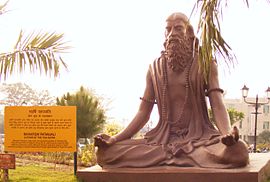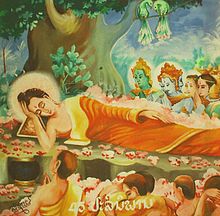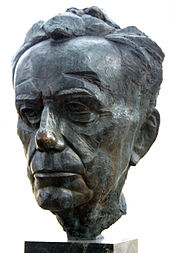- Nontheistic religions
-
Nontheistic religions are traditions of thought within religions, some otherwise aligned with theism, others not, in which nontheism informs religious beliefs or practices.[1] Nontheism has been applied to the fields of Christian apologetics and general liberal theology, and plays significant roles in Buddhism and Hinduism.
Contents
Buddhism
Main article: God in BuddhismAlthough Buddhism has a vast number of scriptures and practices, the fundamental core of Buddhism, the Four Noble Truths and the Noble Eightfold Path do not have any mention of any god(s) or any notion of worship of any deity. They are purely ethical and meditative guidelines based on the truths of psychological suffering due to impermanence.
Since the time of the Buddha, the refutation of the existence of a creator has been seen as a key point in distinguishing Buddhist from non-Buddhist views.[2]
The Buddha said that gods (Pali: devas) exist, though he portrayed them as mortal and, in some cases, deluded. He did not center his teaching around these gods, but instead around the explanation of dukkha (suffering, imperfection) and attaining freedom from it[citation needed].
Although the Buddha did affirm a positive belief in the existence of gods, he stated that they are not to be worshiped and are themselves in the cycle of samsara[citation needed].
The question of a Creator God, however, was answered by Buddha in the Brahmajala Sutta[citation needed]. The Buddha denounced the view of a Creator and sees that such notions are related to the false view of eternity, and like the 61 other views, this belief causes suffering when one is attached to it and relates to these views with desire, hatred and delusion. At the end of the Sutta the Buddha says he knows these 62 views and he also knows the truth that surpasses them.
There are however, pantheistic elements in the doctrine of Adi-Buddha, among others present in buddhism.
Belief and practice
On one occasion, when presented with a problem of metaphysics by the monk Malunkyaputta, Buddha responded with the Parable of the Poison Arrow. When a man is shot with an arrow thickly smeared with poison, his family summons the doctor to have the poison removed, and the doctor gives an antidote:
"But the man refuses to let the doctor do anything before certain questions can be answered. The wounded man demands to know who shot the arrow, what his caste and job is, and why he shot him. He wants to know what kind of bow the man used and how he acquired the ingredients used in preparing the poison. Malunkyaputta, such a man will die before getting the answers to his questions. It is no different for one who follows the Way. I teach only those things necessary to realize the Way. Things which are not helpful or necessary, I do not teach."[3]
Relative and ultimate truth
Some revolutionary Buddhist teachers teach that mention of divine beings in the scriptures does not refer to actual existing gods, but was a language employed by Buddha to bring about a meaning, which was subsequently misunderstood. An example of this is Ajahn Buddhadasa of Thailand[citation needed]. The majority of teachers, however, disagree with this revolutionary interpretation, and teach the orthodox teaching (from the Pali Canon and Mahayana Sutras) that conventional gods do exist and can influence our lives[citation needed]. These gods, however, cannot give people enlightenment, and they are themselves unenlightened and unaware of the true Dhamma[citation needed].
Zen Master Bassui (1327–1387) had strong words for those applying notions of divinity to any separate beings, such as bodhisattvas:
"... so you should realize that all the names of the bodhisattvas are just different names for the nature of mind. As an expedient in the World-Honored-One's sermons, he defined things using certain names, and with these names he pointed to the truth. Ordinary people, unaware of this truth, become attached to the names and, in the hopes of attaining Buddhahood, seek the Buddha and Dharma outside their minds. It's like cooking sand in the hopes of producing rice."[4]
Christianity
Main articles: Secular theology and Christian atheismA few liberal Christian theologians, define a "nontheistic God" as "the ground of all being" rather than as a personal divine being. John Shelby Spong refers to a theistic God as "a personal being with expanded supernatural, human, and parental qualities, which has shaped every religious idea of the Western world."[5]
From a nontheist, naturalist, and rationalist perspective, the concept of divine grace appears to be the same concept as luck.[6]
Bust of Paul Tillich
Many of them owe much of their theology to the work of Christian existentialist philosopher Paul Tillich, including the phrase "the ground of all being". Another quotation from Tillich is, "God does not exist. He is being itself beyond essence and existence. Therefore to argue that God exists is to deny him."[7] This Tillich quotation summarizes his conception of God. He does not think of God as a being which exists in time and space, because that constrains God, and makes God finite. But all beings are finite, and if God is the Creator of all beings, God cannot logically be finite since a finite being cannot be the sustainer of an infinite variety of finite things. Thus God is considered beyond being, above finitude and limitation, the power or essence of being itself.[8]
Secular humanist Sidney Hook wrote in an essay called "The Atheism of Paul Tillich":
With amazing courage Tillich boldly says that the God of the multitudes does not exist, and further, that to believe in His existence is to believe in an idol and ultimately to embrace superstition. God cannot be an entity among entities, even the highest. He is being-in-itself. In this sense Tillich's God is like the God of Spinoza and the God of Hegel. Both Spinoza and Hegel were denounced for their atheism by the theologians of the past because their God was not a Being or an Entity. Tillich, however, is one of the foremost theologians of our time.
Nontheist Friend
Main article: Nontheist FriendA nontheist Friend or an atheist Quaker is someone who affiliates with, identifies with, engages in and/or affirms Quaker practices and processes, but who does not accept a belief in a theistic understanding of God, a Supreme Being, the divine, the soul or the supernatural. Like theistic Friends, nontheist Friends are actively interested in realizing centered peace, simplicity, integrity, community, equality, love, happiness and social justice in the Society of Friends and beyond.
Hinduism
Main article: Atheism in HinduismHinduism is generally regarded as being characterised by extremely diverse beliefs and practises.[9] In the words of R.C. Zaehner, "it is perfectly possible to be a good Hindu whether one's personal views incline toward monism, monotheism, polytheism, or even atheism."[10] He goes on to say that it is a religion that neither depends on the existence or non-existence of God or Gods.[11] More broadly, Hinduism can be seen as having three more important strands: one featuring a personal Creator or Divine Being, one that emphasises an impersonal Absolute and a third pluralistic and non-absolute.[12] Some scholars regard devotion to a personal deity as the ultimate reality is the last and perhaps most significant stage of Hinduism's development.[10] This article will focus on the latter two traditions - which can be seen as nontheistic.[13]
Although the Vedas are broadly concerned with the completion of ritual, there are some elements that can be interpreted as either nontheistic or precursors to the later developments of the nontheistic tradition. The oldest Hindu scripture, the Rig Veda mentions that 'There is only one god though the sages may give it various names' (1.164.46). Max Müller termed this henotheism, and it can be seen as indicating one, non-dual divine reality, with little emphasis on personality.[14] The famous Nasadiya Sukta, the 129th Hymn of the tenth and final Mandala (or chapter) of the Rig Veda, considers creation and asks "The gods came afterwards, with the creation of this universe. /Who then knows whence it has arisen?".[15] This can be seen to contain the intuition that there must be a single principle behind all phenomena: 'That one' (tad ekam), self-sufficient, to which distinctions cannot be applied.[16][17]
It is with the Upanishads, reckoned to be written in the first millennia (coeval with the ritualistic Brahmanas), that the Vedic emphasis on ritual was challenged. The Upanishads can be seen as the expression of new sources of power in India. Also, separate from the Upanishadic tradition were bands of wandering ascetics called Vadins whose largely nontheistic notions rejected the notion that religious knowledge was the property of the Brahmins. Many of these were shramanas, who represented a non-Vedic tradition rooted in India's pre-Aryan history.[18] The emphasis of the Upanishads turned to knowledge, specifically the ultimate identity of all phenomena.[19] This is expressed in the notion of Brahman, the key idea of the Upanishads, and much later philosophizing has been taken up with deciding whether Brahman is personal or impersonal.[20] The understanding of the nature of Brahman as impersonal is based in the definition of it as 'ekam eva advitiyam' (Chandogya Upanishad 6.2.1) - it is one without a second and to which no substantive predicates can be attached.[21] Further, both the Chandogya and Brihadaranyaka Upanishads assert that the individual atman and the impersonal Brahman are one.[22] The mahāvākya statement Tat Tvam Asi, found in the Chandogya Upanishad, can be taken to indicate this unity.[23] The latter Upanishad uses the negative term Neti neti to 'describe' the divine.
 Patañjali statue in Pantanjali Yog Peeth Haridwar
Patañjali statue in Pantanjali Yog Peeth Haridwar
Classical Samkhya, Mimamsa, early Vaisheshika and early Nyaya schools of Hinduism do not accept the notion of an omnipotent creator God at all.[24][25] While the Sankhya and Mimamsa schools no longer has significant followings in India, they are both influential in the developent of later schools of philosophy.[26][27] The Yoga of Patanjali is the school that probably owes most to the Samkhya thought. This school is dualistic, in the sense that there is a division between 'spirit' (Sanskrit: purusha) and 'nature' (Sanskrit: prakṛti).[28] It holds Samadhi or 'concentrative union' as its ultimate goal[29] and it does not consider God's existence as either essential or necessary to achieving this.[30]
The Bhagavad Gita, contains both passages which bear a monistic reading and others which bear a theistic reading.[31] Generally, the book as a whole has been interpreted by some who see it as containing a primarily nontheistic message,[32] and by others who stress its theistic message.[33] These broadly either follow after either Sankara or Ramanuja[34] An example of a nontheistic passage might be "The supreme Brahman is without any beginning. That is called neither being nor non-being." Which was interpreted by Sankara to mean that Brahman can only be talked of in terms of negation of all attributes - 'Neti neti'.[35]
The Advaita Vedanta of Gaudapada and Sankara rejects theism as a consequence of its insistence that Brahman is "Without attributes, indivisible, subtle, inconceivable, and without blemish, Brahman is one and without a second. There is nothing other than He."[36] This means that it lacks properties usually associated with God such as omniscience, perfect goodness, omnipotence, and additionally is identical with the whole of reality, rather than being a causal agent or ruler of it.[37]
Jainism
Main article: God in JainismFurther information: Jainism and non-creationismJainism is a dualistic religion, with the universe made up of matter and souls.[38] The universe, and the matter and souls within it, are eternal and uncreated, and there is no omnipotent creator god in Jainism. There are, however, "gods" and other spirits who exist within the universe, and Jains believe that the soul can attain "godhood"; however none of these supernatural beings exercise any sort of creative activity or have the capacity or ability to intervene in answers to prayers.
Besides scriptural authority, Jains also employ syllogism and deductive reasoning to refute creationist theories. Various views on divinity and the universe held by the vedics, sāmkhyas, mimimsas, Buddhists, and other school of thoughts were criticized by Jain Ācāryas, such as Jinasena in Mahāpurāna.
See also
References
- ^ Williams, J. Paul; Horace L. Friess (1962). "The Nature of Religion". Journal for the Scientific Study of Religion (Blackwell Publishing) 2 (1): 3–17. doi:10.2307/1384088. JSTOR 1384088.
- ^ B. Alan Wallace, Contemplative Science. Columbia University Press, 2007, pages 97-98.
- ^ Nhat Hanh, Thich (1991). Old Path White Clouds: walking in the footsteps of the Buddha. Parallax Press. pp. 299. ISBN 0-938077-26-0.
- ^ Braverman, Arthur (2002). Mud and Water: The Teachings of Zen Master Bassui. Wisdom Publications. pp. 56. ISBN 0-86171-320-6.
- ^ A New Christianity for a New World: Why Traditional Faith Is Dying and How a New Faith Is Being Born, ISBN 0-06-067063-0
- ^ Kaufman, Arnold S. "Ability", The Journal of Philosophy, Vol. 60, No. 19
- ^ Tillich, Paul. (1951) Systematic Theology, p.205.
- ^ Sidney Hook, "The Atheism of Paul Tillich", in Religious Experience and Truth: A Symposium ed. Sidney Hook. (New York University Press, 1961).
- ^ Catherine Robinson, Interpretations of the Bhagavad-Gītā and Images of the Hindu Tradition: The Song of the Lord. Routledge Press, 1992, page 17.
- ^ a b Catherine Robinson, Interpretations of the Bhagavad-Gītā and Images of the Hindu Tradition: The Song of the Lord. Routledge Press, 1992, page 51.
- ^ R. C. Zaehner, (1966) Hinduism, P.1-2, Oxford University Press.
- ^ Smart, Ninian,(1999) World Philosophies. Routledge, ISBN 0415184665 p.35
- ^ Griffiths, Paul J, (2005) Nontheistic Conceptions of the Divine Ch. 3. in The Oxford Handbook of Philosophy of Religion by William J Wainwright, p.59 . Oxford University Press US, ISBN 0195138090
- ^ Masih, Y. A comparative study of religions, P.164, Motilal Banarsidass Publ., 2000 ISBN 8120808150
- ^ O'Flaherty, Wendy Doniger, (1981)The Rig Veda: An Anthology of One Hundred Eight Hymns (Classic) Penguin
- ^ Collinson, Diané and Wilkinson, Robert Thirty-Five Oriental Philosophers, P. 39, Routledge, 1994 ISBN 0415025966
- ^ Mohanty, Jitendranath (2000), Classical Indian Philosophy: An Introductory Text, p:1 Rowman & Littlefield, ISBN 0847689336
- ^ Jaroslav Krejčí, Anna Krejčová (1990) Before the European Challenge: The Great Civilizations of Asia and the Middle East, p:170, SUNY Press, ISBN 0791401685
- ^ Doniger,Wendy, (1990) Merriam-Webster's Encyclopedia of World Religions,P. 441, Merriam-Webster, ISBN 0877790442
- ^ Smart, Ninian (1998) The World's Religions P.73-74, CUP ISBN 0521637481
- ^ Wainwright, William J. (2005) Ch.3 Nontheistic conceptions of the divine. The Oxford Handbook of Philosophy of Religion p.67 OUP, ISBN 0195138090
- ^ Jones, Richard H. (2004) Mysticism and Morality: A New Look at Old Questions, P. 80, Lexington Books, ISBN 0739107844
- ^ Brown, Robert L,(1991) Ganesh: Studies of an Asian God, SUNY Press, ISBN 079140656.
- ^ Larson, Gerald James, Ch. Indian Conceptions of Reality and Divinity found in A Companion to World Philosophies By Eliot Deutsch, Ronald Bontekoe, P. 352, Blackwell, ISBN 0631213279
- ^ Morgan, Kenneth W. and Sarma, D S, Eds. (1953) Ch. 5. P.207 Hindu Religious Thought by Satis Chandra Chatterjee, The Religion of the Hindus: Interpreted by Hindus, Ronald Press. ISBN 8120803876
- ^ Flood, Gavin D, An Introduction to Hinduism,(p.232) CUP, ISBN 052143878
- ^ Larson, Gerald James,(1999) Classical Samkhya, Motilal Banarsidass Publishers, ISBN 8120805038
- ^ Feuerstein, Georg (1989), Yoga: The Technology of Ecstasy, Tarcher, ISBN 0874775205
- ^ King, Richard (1999) Indian Philosophy: An Introduction to Hindu and Buddhist Thought, p:191, Edinburgh University Press, ISBN 0748609547
- ^ Clements, Richard Pauranik, Being a Witness in Theory and Practice of Yoga by Knut A. Jacobsen
- ^ Yandell, Keith. E., On Interpreting the "Bhagavadgītā", Philosophy East and West 32, no 1 (January, 1982).
- ^ Catherine Robinson, Interpretations of the Bhagavad-Gītā and Images of the Hindu Tradition: The Song of the Lord. Routledge Press, 1992, page 45, 98, 115, 136.
- ^ Catherine Robinson, Interpretations of the Bhagavad-Gītā and Images of the Hindu Tradition: The Song of the Lord. Routledge Press, 1992, pages 47, 51.
- ^ Flood, Gavin D, An Introduction to Hinduism, (pps 239-234) CUP, ISBN 052143878
- ^ Swami Gambhirananda, (1995), Bhagavadgita: with the Commentary of Sankaracharya, Ch. 13. Vs. 13, Advaita Ashrama, Calcutta ISBN 8175051507
- ^ Richards, John, Viveka-Chudamani of Shankara Vs 468.
- ^ Wainright, William, (2006), Concepts of God, Stanford Encyclopedia of Religion
- ^ http://raider.mountunion.edu/re/worldreligions/jainsite1.htm
Irreligion Atheism List of atheists · Demographics · Religion · History · Anti-clericalism · State atheism · Criticism · Discrimination · Negative and positive · Implicit and explicit · Antitheism · Antireligion · Atheist Alliance International · Christian atheism · Atheism in Hinduism · Jewish atheism
Agnosticism Nontheism Naturalism Related topics Irreligion by country · Unaffiliated
Philosophy of religion Concepts in religion Afterlife · Euthyphro dilemma · Faith · Intelligent design · Miracle · Problem of evil · Religious belief · Soul · Spirit · Theodicy · Theological veto
Theories of religion Acosmism · Agnosticism · Animism · Antireligion · Atheism · Dharmism · Deism · Divine command theory · Dualism · Esotericism · Exclusivism · Existentialism (Christian · Agnostic · Atheist) · Feminist theology · Fundamentalism · Gnosticism · Henotheism · Humanism (Religious · Secular · Christian) · Inclusivism · Monism · Monotheism · Mysticism · Naturalism (Metaphysical · Religious · Humanistic) · New Age · Nondualism · Nontheism · Pandeism · Pantheism · Perennialism · Polytheism · Process theology · Spiritualism · Shamanism · Taoic · Theism · Transcendentalism · more...
Philosophers
of religionAlbrecht Ritschl · Alvin Plantinga · Anselm of Canterbury · Antony Flew · Anthony Kenny · Augustine of Hippo · Averroes · Baron d'Holbach · Baruch Spinoza · Blaise Pascal · Bertrand Russell · Boethius · D. Z. Phillips · David Hume · Desiderius Erasmus · Emil Brunner · Ernst Cassirer · Ernst Haeckel · Ernst Troeltsch · Friedrich Schleiermacher · Friedrich Nietzsche · Gaunilo of Marmoutiers · Georg Wilhelm Friedrich Hegel · George Santayana · Harald Høffding · Heraclitus · Jean-Luc Marion · Lev Shestov · Loyal Rue · Martin Buber · Martin Lings · Mircea Eliade · Immanuel Kant · J. L. Mackie · Johann Gottfried Herder · Karl Barth · Ludwig Feuerbach · Maimonides · Paul Tillich · Pavel Florensky · Peter Geach · Pico della Mirandola · Reinhold Niebuhr · René Descartes · Rene Guenon · Richard Swinburne · Robert Merrihew Adams · Rudolf Otto · Søren Kierkegaard · Sergei Bulgakov · Thomas Aquinas · Thomas Chubb · Vladimir Solovyov · Walter Kaufmann · William Alston · William James · William Lane Craig · W.K. Clifford · William L. Rowe · William Whewell · William Wollaston · more...
Existence of God ForBeauty · Christological · Consciousness · Cosmological · Degree · Desire · Experience · Love · Miracles · Morality · Ontological · Pascal's Wager · Proper basis · Reason · Teleological (Natural law) · Transcendental · Witness
AgainstRelated topics Criticism of religion · Exegesis · History of religions · Religion · Religious philosophy · Theology · Relationship between religion and science · Political science of religion · Faith and rationality · more...
Theology Apologetics GeneralBahá'íChristianChristian apologetics · Christian apologists · List of Christian apologetic works · Ecumenical Apologetics · Presuppositional apologetics · Epistle to Diognetus · Trilemma · Urmonotheismus · More...MuslimMuslim apologistsConceptions of God Divine presenceGod as theGod inAbrahamic religions · Bahá'í Faith · Buddhism · Christianity · Hinduism · Islam · Jainism · Judaism · Sikhism · Zoroastrianism · More...Names of God inSingular GodBinitarianismTrinitarianismOtherAristotelian view of God · Attributes · Demiurge · Divine simplicity · Egotheism · Godhead (Christianity) · Godhead (Latter Day Saints) · Great Architect of the Universe · Great Spirit · Apophatic theology · Olelbis · Open theism · Personal god · Phenomenological definition of God · Philo's view of God · Sarav viāpak · Taryenyawagon · The All · Tian · Unmoved mover · More...Eschatology Afterlife · Apocalypticism · Buddhist · Christian · Concepts of Heaven · Doomsday films · Ghost Dance Movement · Ghosts · Hindu · Islamic · Jewish · Personifications of death · Taoist · Zoroastrian · MoreExistence of God arguments againstfromotherarguments forfromA proper basis · Beauty · Consciousness · Degree · Desire · Love · Miracles · Morality · Reason · Religious experienceotherChristological · Cosmological · Ontological · Pascal's wager · Teleological · Trademark · Transcendental · Witness · More...Opposition to religion Anti-Buddhism (Criticism · Persecution) · Catholicism · Christianity (Criticism · anti-Christian sentiment · Persecution) · Gnosticism · Hinduism (Criticism) · Islam (Criticism · Islamophobia · Persecution) · Jainism (Criticism) · Judaism (Criticism) · Protestantism · cult movement · Zoroastrianism · More...OtherTheism List of philosophical theories · Deity (Divinity · Numen · Male · Female · Gender of) · Deism · Dystheism · Henotheism · Hermeticism · Kathenotheism · Nontheism · Monolatrism · Monotheism · Mysticism · Panentheism · Pandeism · Pantheism · Polydeism · Polytheism · Spiritualism · Theopanism · More...Theologies History of · Outline · of the Bible · Terms · Christology · Cosmology · Ecclesiology · Ethics · Hamartiology · Law · Messianism · Movements · Nestorianism · New testament · Old testament · Philosophy · Practical · Sophiology · Soteriology · More...HinduJewishOtherEducation Anglican · Buddhist · Eastern Orthodox · Evangelical · Islamic · Jewish · Lutheran · Madrassas · Methodist · Reformed Church · Roman Catholic · More...Schools by religious affiliationBahá'í · Buddhist · Anglican · Assemblies of God · Baptist · Eastern Orthodox · Hindu · Islamic · Jewish · Latter Day Saints · Lutheran · Mennonite · Methodist · Nondenominational Christian · Presbyterian · Quaker · Roman Catholic · Seventh-Day AdventistResources List of theological journals · More...Practitioners Teachers · TheologiansCategories:
Wikimedia Foundation. 2010.



